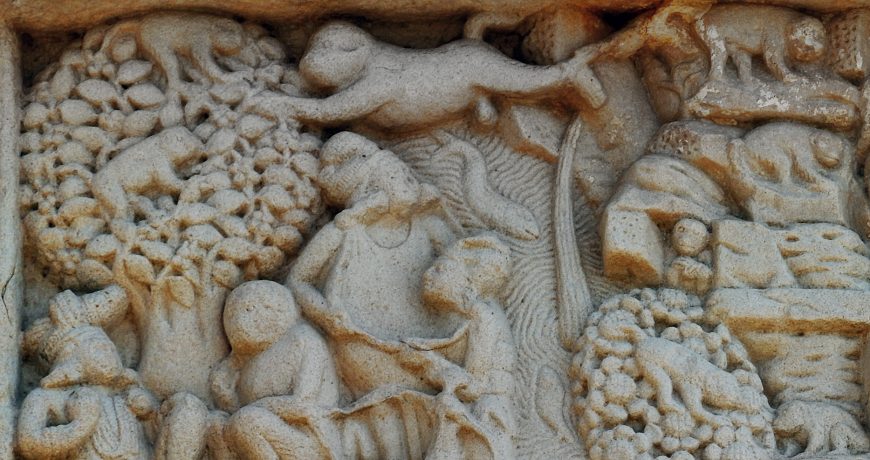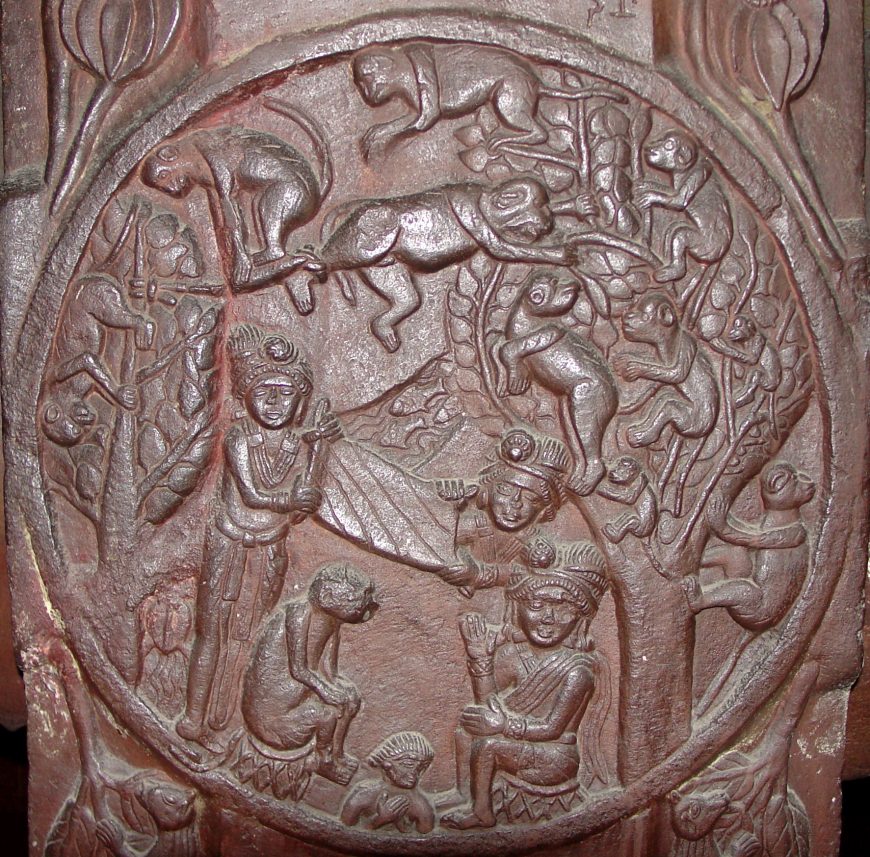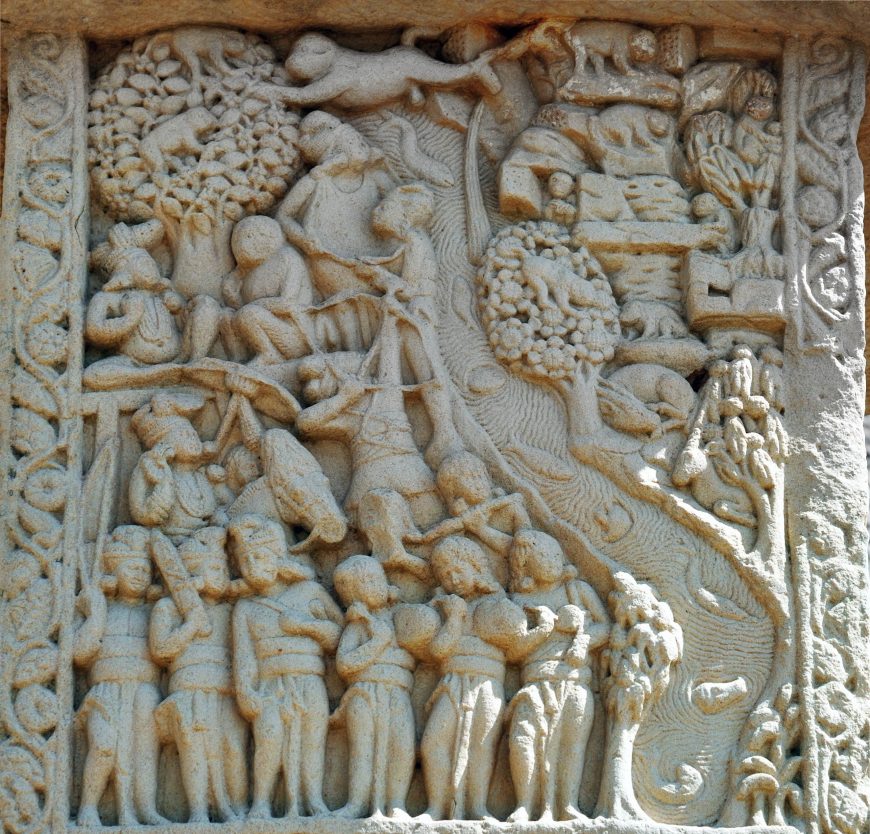
Detail, Mahakapi Jataka, Stupa 1 (the Great Stupa) at Sanchi (Madhya Pradesh), on a pillar of the west gateway/torana, dated c. 1st century B.C.E. – c. 1st century C.E.
Jatakas — the stories about virtues
Imagine a six-tusked elephant salvaging the lives of men while losing its own in an ordeal, or a monkey king saving the lives of his fellow monkeys by stretching his body between two trees to make a bridge for their safety. Stories like these recall tales told by parents or grandparents as bedtime stories for children. In a different context, however, these stories form an integral part of Buddhist Jataka tales.
The Jatakas are an important part of Buddhist art and literature. They describe the previous existences or births of the Buddha (the Enlightened One) when he appeared as Bodhisattvas (beings who are yet to attain enlightenment or moksha), in both human and non-human forms. These stories tell us how practicing different perfections or transcendental virtues (which are usually termed paramitas) are key to Buddhist approaches for attaining enlightenment (moksha) or the release from samsara, the endless cycle of rebirth.
Where to find the Jatakas
The literary text called the Jataka contains more than 500 tales and constitutes the tenth book of the fifteen texts written in the ancient Indic language of Pali that comprise the Khuddaka Nikaya of the Sutta Pitaka (the second of the Tripitaka or Buddhist Pali canon dealing with the doctrinal section of the Hinayana, a sect of Buddhism that emphasized the life of the Historical Buddha, Shakyamuni). The extant Jataka text that has come down to us is a commentary on the original Pali canonical Jataka book, which was in verse form. A few Jataka tales can also be traced to the Cariya Pitaka, the Buddhavamsa, and other parts of the Pali canon.
From story to a “Jataka”
Although it is beyond doubt that a large portion of the Jataka content is peculiar to Buddhism, these stories contain an unrivaled collection of folklore that likely circulated outside of Buddhist communities. A large number of Jatakas originally belonged to ancient Indian storytelling or narrative traditions that were both rich and varied. Telling stories, fables, anecdotes and fairy tales is a favorite method by which leaders of world religions seek more followers and increased popularity for their faiths. The inclusion of folk or popular components in the Jatakas ultimately enabled them to reach larger audiences through narrative elements that people could easily identify with. In some cases, a mundane or arbitrary story, originally unrelated to Buddhist ideas, was “buddhicized” and turned into a Jataka story.
Jatakas in art
Apart from the oral and literary forms, Jatakas reached the laity and monks through art, which proved to be a powerful tool in communicating Buddhist tenets and philosophy to a wide public. Jatakas are often found in sculptural reliefs or paintings in Buddhist stupas (Buddhist shrines with dome-shaped structures) and caves. It is no surprise, therefore, that the popularity of several Buddhist sites in what is now India, Bharhut, Sanchi, Amaravati, Ajanta and Nagarjunakonda, also feature brilliantly-produced Jataka depictions. Artists developed ingenious and visually effective methods to tell the Jataka stories without losing their essence and while making them easily understandable for a wide audience.
The story of the Great Monkey King at Bharhut
One Jataka story that became popular in Buddhist art is the Mahakapi Jataka. This Jataka describes how the Bodhisattva was born as a Great Monkey who dwelled in a beautiful Himalayan forest among a large troop of monkeys. According to the story, near the bank of the river Ganges a huge Banyan tree bore fruits with divine fragrance and flavor. Though the Great Monkey (the Bodhisattva) and his troop took utmost care to see that no fruit grew or fell from the branch that stretched towards the Ganges, one ripe fruit did fall into the river and was caught in the net of a fisherman who showed the fruit to the king of Benaras. The king went to the tree with his retinue and saw the monkeys eating the fruits. Annoyed, he ordered his archers to shoot them. The frightened monkeys approached the Bodhisattva, who comforted them and told them not to worry. He tried to make a bamboo bridge between the tree and another tree on the other side of the river. But somehow the bamboo shoot fell short of the length required to form the bridge. Realizing this, the Bodhisattva stretched himself at the end, so that his herd could pass safely over on his back. The monkeys escaped—treading on the back of the Bodhisattva. As the Mahakapi Jataka explains, the king was filled with deep emotion to see how the Bodhisattva endangered his own life for the safety of his retinue. The king commanded his attendants to safely bring down the Bodhisattva.

Mahakapi Jataka, roundel relief, Bharhut stupa, Madhya Pradesh, India, c. 2nd century B.C.E. – 1st century B.C.E. (Indian Museum, Kolkata, West Bengal, India)
A stunning representation of this Jataka is found in a medallion at Bharhut (an important Buddhist site in the present-day state of Madhya Pradesh, India). We see several moments of the story in this one medallion. The scene is divided into two by a flowing river shown teeming with fish. Flanking the river are two trees: the one on the right is inhabited by the monkeys, and the other, smaller tree on the left is the tree they escape to. In the middle of these trees the Great Monkey (the Bodhisattva) has fastened one end of the bamboo stem to the top of the tree on the left and the other end to the ankle of his right leg. He clings to two smaller upper branches of the tree on the right to form a bridge.
The artist(s) depict monkeys actively moving between the two trees that frame this scene: several monkeys clamber amidst the branches of the large banyan, one monkey appears to be leaping over the Bodhisattva’s back, and two lucky monkeys have safely reached the far side. Below we see the next moment of the story with two men holding a piece a fabric as a safety net to catch the Great Monkey as he jumps down from the tree. In the final scene at the bottom, the Bodhisattva and the king sit across from one other, as the Bodhsiattva instructs the king in Buddhist law before dying from the wounds sustained during his dramatic feat to save the troop. The story tells us that the king then honored the Great Monkey with royal funeral rites.
Another version at Sanchi
Another depiction of the Mahakapi Jataka appears on the western gateway of the Great Stupa (Stupa 1) at Sanchi, also in Madhya Pradesh, India. The first scene, depicted at the bottom, shows the arrival of the king of Benaras, mounted on a horse accompanied by soldiers. The king is shown with a parasol or chatra over his head, which signifies his royal status. A feature that arouses curiosity is the portrayal of musicians who accompany the king—perhaps meant to accentuate the royal status of the king, suggesting that he travels with an entourage of attendants and musical accompaniment. To the right of the king an archer appears with bow and arrow aiming at the Bodhisattva (Great Monkey).

Mahakapi Jataka, Stupa 1 (the Great Stupa) at Sanchi (Madhya Pradesh), on a pillar of west gateway /torana, dated ca. 1st century B.C.E. – 1st century C.E.
As at Bharhut, the artist(s) of the Sanchi relief show the Bodhisattva as the bridge by which monkeys escape to join the rest of the troop in the forest. On the left side of the river (which in this relief is full of active fish and rhythmic waves of water), two men, presumably following the order of the king, appear holding a sheet below the Great Monkey as he falls. The episodes depicted in the Sanchi panel give no indication of order through either time or cause and effect. Such is the complexity of this portrayal that even a viewer well-versed in this story must closely examine the panel, as art historian Vidya Dehejia puts it, to “read” it accurately. Apparently, the artist made this for an audience with previous knowledge of the Jataka stories.
The many other virtuous deeds and sacrifices of the Bodhisattva which make Jatakas extremely popular among the Buddhist community or sangha are included in such stories as Chaddanta, Vishvantara, Vidhurapandita, Ruru, Mahajanaka and Hamsa Jatakas. The Jatakas came to be portrayed in Central Asia, Afghanistan, China, Japan and Sri Lanka, leaving an indelible mark on Buddhist art and literature in the regions beyond the Indian subcontinent—becoming an inseparable part of Buddhist tradition.

